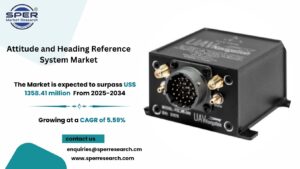RF Components Market Demand, Rising Revenue, Share, Key Players, Challenges, Future Opportunities and Forecast Analysis till 2033: SPER Market Research

Electronic systems that process, transmit, and regulate signals in the radio frequency spectrum—which normally spans from 3 kHz to 300 GHz—need radio frequency (RF) components. These components are essential to broadcasting, radar, wireless communication systems, and many other applications. Common RF components include oscillators, which produce steady frequencies for signal transmission, amplifiers, which increase the power of RF signals, and antennas, which transform electrical impulses into radio waves and vice versa. To ensure the purity of the signal, filters are employed to choose or reject particular frequencies. Information is extracted from modulated transmissions by detectors or demodulators, whilst mixers combine many radio frequency signals to create new frequencies.
According to SPER Market Research, ‘Global Radio Frequency Components Market Size- By Component, By Application – Regional Outlook, Competitive Strategies and Segment Forecast to 2033’ states that the Global Radio Frequency Components Market is estimated to reach USD 134.66 billion by 2033 with a CAGR of 13.71%.
Drivers: The growing use of wireless communication technologies is driving the need for radio frequency (RF) components, which are essential for effective signal transmission in devices like smartphones, tablets, and Internet of Things systems. Since wireless connections are predicted to grow at an annual pace of 11% between 2024 and 2032, there will be a greater need for RF components. The expansion of the Internet of Things, which currently comprises billions of connected devices, is another factor driving this requirement. The introduction of 5G networks is another important factor because RF components are essential to 5G infrastructure, such as base stations and antennas.
Restraints: A number of obstacles prevent the market for radio frequency (RF) components from expanding. Since developing components that function well at these higher frequencies necessitates the use of more sophisticated materials and technologies, one of the largest problems is the growing demand for bandwidth and higher frequency bands. This calls for constant innovation in manufacturing procedures as well as the creation of new materials, like sophisticated semiconductors and substrates. In addition, a large number of competitors are fighting for market share, which puts pressure on profit margins and prices. Furthermore, in order to achieve regulatory standards and ensure that RF components adhere to norms, significant investment in research, development, and testing is usually required.
Request For Free Sample Report @ https://www.sperresearch.com/report-store/radio-frequency-components-market.aspx?sample=1
Impact of COVID-19 on Global Radio Frequency Components Market
The unexpected COVID-19 pandemic development is expected to have an effect on the RF components market. The COVID-19 pandemic severely hindered the market’s growth in the first half of 2020 for RF components. Some government and regulatory agencies implemented stringent lockdowns in early 2020 in an effort to stop the COVID-19 virus’s spread. Due to trade restrictions and interruptions in the supply chains for components and raw materials, the market demand for RF components has decreased throughout the epidemic. However, as of 2022, a number of RF component manufacturers reorganized their supply chains by collaborating with regional raw material suppliers.
Global Radio Frequency Components Market Key Players:
Additionally, some of the market key players are, Analog Devices Inc., Arrow Electronics Inc., Cree Inc., Murata Manufacturing Co. Ltd, NXP Semiconductors NV.
For More Information, refer to below link: –
Radio Frequency Components Market Share
Related Reports:
Follow Us –
LinkedIn | Instagram | Facebook | Twitter
Contact Us:
Sara Lopes, Business Consultant — USA
SPER Market Research
+1–347–460–2899





